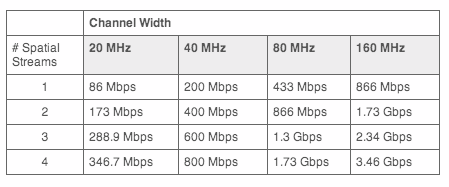The short answer to that question is, no. Explaining why, however, that’s where things get really interesting… It’s also one of those explanations that require a person to understand the real-world throughput in real-world scenarios for wireless environments, instead of just listening to all the marketing buzz and fancy technical specifications that wireless manufacturers would have you believe.
Yes, 802.11ac wave 2 wireless manufacturers readily advertise speeds greater than 1.7Gb+, which might give you the impression that the existing Cat-5E copper cabling pulled to your current access points would need to be replaced, or that you might have to run two cables to each individual access point, but you won’t be seeing those 1.7Gb+ throughput speeds anytime in the near future outside of a testing lab or controlled situation.
First, let me start out by saying that if you’re deploying new wireless access points, there’s nothing wrong with pulling two cable pulls to each access point -if- your budget allows for it in an attempt to help future proof your cabling infrastructure over the next 10+ years. However, at this time, pulling (2) Cat-6a cables for new access points isn’t going to gain you one bit (a pun!) of performance as it relates to current wireless architectures available.
I support countless schools that have anywhere from 15-500 access points deployed throughout their various buildings – all with wireless networks that have been designed for 1:1 and Bring Your Own Device initiatives. Even with those high density environments that are providing thousands and thousands of concurrent client connections, there is little need to replace all the current copper cabling merely because of the 802.11ac wave 2 standards and planned implementations.

This Wisconsin manufacturer needed to modernize its IT infrastructure to support rapid business growth.
Discover what they didWhy? Well, let’s take a closer look at some of the things that the 802.11ac wave 2 marketing blitz and campaigns don’t come right out and tell you.
802.11ac wave 2 wireless – fact vs. marketing
- Theoretical Numbers — When you see wireless manufacturers advertising 300Mb or 866Mb or 1.7Gb, those numbers are only theoretical and not what’s actually attainable. Throughput in the real world, even in best case scenarios, is only about HALF of that when you factor in overhead for TCP, overhead for encryption, etc. Furthermore, those numbers also represent theoretical maximums under absolute “perfect” RF conditions which never actually happen in the real-world.
- Client Chipsets — In general, client devices are still going to be 1:1:1 (phones), or 2:2:2 (laptops/tablets), with only the small percentage of high-end devices utilizing a wireless card with 3:3:3 capability. That translates into wireless data rates that aren’t even coming close to the theoretical maximum of what 802.11ac wave 2 is capable of. (receive antennas : transmit antennas : # of spatial streams)
- Spatial Streams — There are no clients currently available that even support 4 spatial streams (and it will definitely be awhile before there are) which would be needed to achieve the ultra-high speeds that 802.11ac wave 2 wireless is capable of providing.
- Channel Width — The highest speeds attainable in wave 2 are done so using 160Mhz channel width which are ONLY meant for home use. Deploying 160Mhz channel widths in an enterprise environment is impossible and just plain stupid because of the channel-overlap issues that would occur. 40Mhz and 80Mhz channel widths should probably be your only considerations when deploying wireless in an enterprise environment (which will reduce the overall throughput capabilities).
- Half Duplex — even with the new MU-MIMO features of 802.11ac, the transmissions are still half-duplex (shared airspace for upload/download), whereas wired Ethernet is full-duplex (separate upload and download speeds).
- Distance Factor — in order to utilize the highest data rates available in 802.11ac wave 2, clients need a very high SNR value which means near-perfect RF conditions and the client needing to be within 10-15 feet of the AP it’s connected to. The further away you go from the access point, the more your connection speed drops in favor of having a more reliable wireless connection.
- MU-MIMO Limitations — Yes, for the first time ever, 802.11ac wave 2 makes it possibility to share the wireless airspace with multiple clients at the same time, but ONLY in a download direction (uploads are still limited to 1 client using the airspace at a time). MU-MIMO is limited to 3 clients at most however (this has the potential to increase to 7 as manufacturers eventually release future 802.11ac wave 2 (8:8:8) access points in the years to come). Bear in mind, having multiple clients sharing the airspace won’t actually increase cumulative throughput. It merely allows for improved airtime fairness and efficiency. Because of the way MU-MIMO works, clients participating in MU-MIMO and sharing wireless airspace will actually need to reduce the number of spatial streams they use. Fewer spatial streams equals lower data rates.
- Applications — Finding any sort of application in the real-world that is truly capable of saturating a 1Gb link is highly unlikely. Saturating the 1Gb copper link from the access point back to your switch is possible only under specific testing scenarios and testing conditions (think: UDP, not TCP), but don’t expect to see it in the real-world when 99% of your wireless users are surfing the internet or accessing some random application.

When you understand the technical pieces behind 802.11ac wave 2 and look at real environments outside of a testing lab situation, you can easily see that your old/dated Cat-5e cabling is more than capable of handling any network traffic coming from your newly installed 802.11ac wave 2 wireless infrastructure, regardless of what the supposed sales-experts and marketing briefs tell you.
That being said, the advances in 802.11ac wave 2 wireless as it relates to theoretical maximum speeds and shared airspace is pretty awesome and spells amazing things for the future when it comes to wireless design and rollouts. It’s definitely exciting watching the the industry trends and improvements in wireless technologies today versus where we were only 10 years ago!
In a forthcoming article, I am going to discuss some intriguing alternatives to replacing your existing Cat-5e and Cat-6 copper cabling when you do eventually require 1Gb+ speeds at your APs. The new standards released by the NBASE-T Alliance will boost the speed of legacy twisted-pair wiring to speeds of 2.5Gb and 5Gb speeds over distances of 100 meters (HP calls it “Smart Rate” and Cisco calls it “Multigigabit”).




